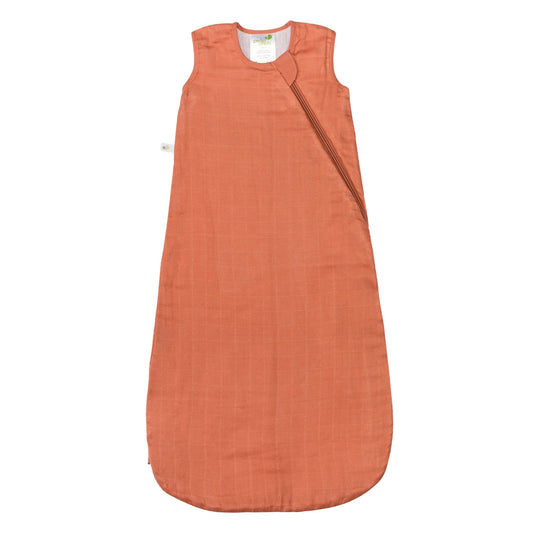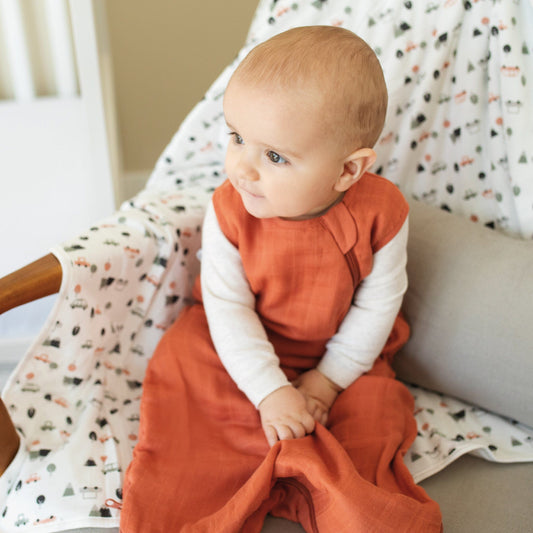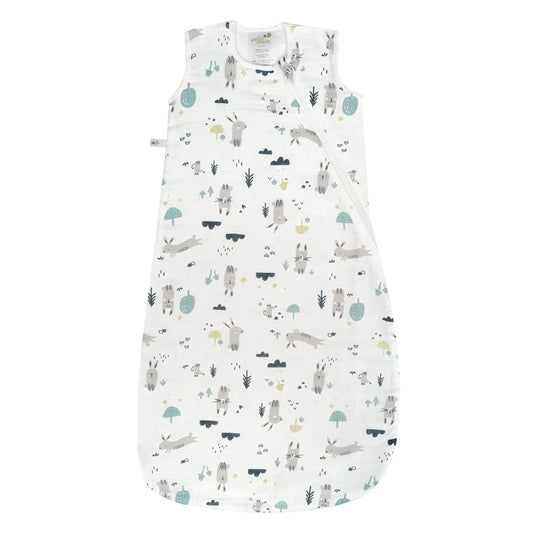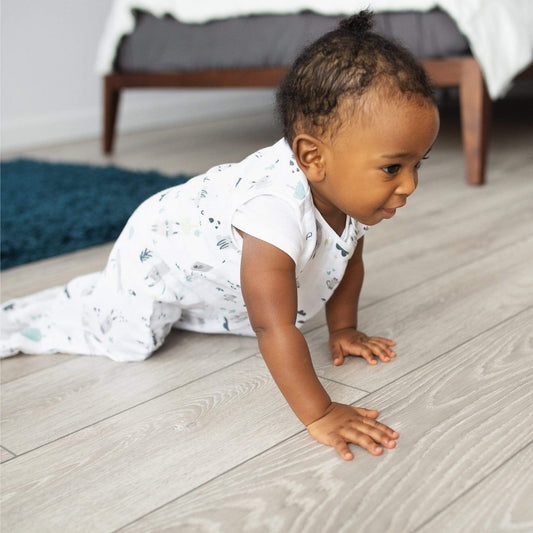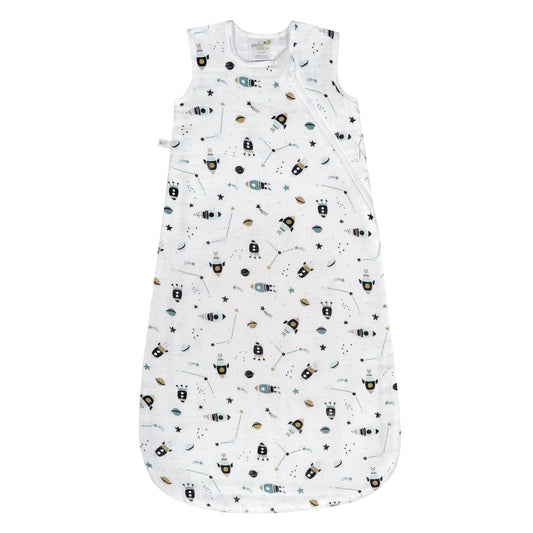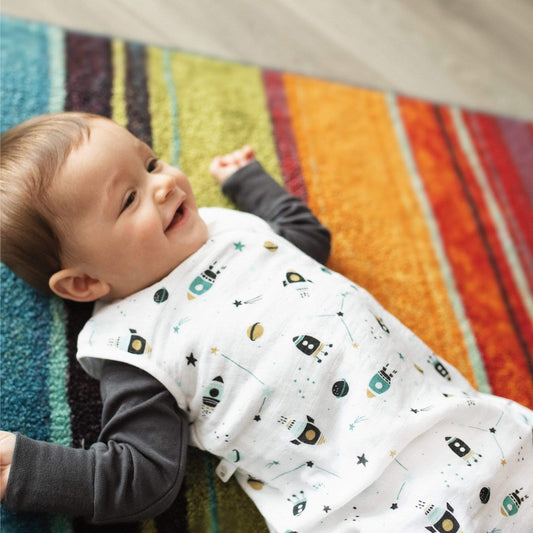-
Cotton muslin sleep sack - Cinnamon (0.7 tog)
Regular price $47.00 USDRegular priceUnit price per$0.00 USDSale price $47.00 USD -
Cotton muslin sleep sack - Bunnies (0.7 tog)
Regular price $33.00 USDRegular priceUnit price per$47.00 USDSale price $33.00 USDSale -
Cotton muslin sleep sack - Rockets (0.7 tog)
Regular price $33.00 USDRegular priceUnit price per$47.00 USDSale price $33.00 USDSale
What is a baby sleep sack?
A baby sleep sack is a wearable blanket designed for infants. It's a safe alternative to traditional blankets that can reduce the risk of Sudden Infant Death Syndrome (SIDS) by preventing the covering from going over the baby’s head during sleep. It allows babies to stay warm and comfortable without the use of loose bedding. Sleep sacks come in various sizes and materials suitable for different climates and seasons, and should be chosen based on the baby's age, size, and mobility.
Bamboo Sleep Sacks: Eco-Friendly Softness
For parents in humid areas like the Southeastern U.S., bamboo sleep sacks offer unparalleled softness and moisture-wicking properties. Bamboo is an eco-friendly material, perfect for maintaining comfort in temperatures around 75°F to 80°F. Its natural antibacterial qualities also ensure a hygienic sleep environment for your baby. Discover our Bamboo Sleep Sack Range.
Muslin Sleep Sacks: Lightweight and Airy
Muslin is the go-to material for hot, dry areas like the Southwestern U.S. It's incredibly lightweight and breathable, suitable for temperatures above 80°F. Muslin's open weave allows for air circulation, preventing overheating and ensuring a peaceful sleep for your baby. Check out our Muslin Sleep Sack Assortment.
Cotton Sleep Sacks: The Classic Comfort
Cotton baby sleep sacks are ideal for parents in moderate climates like the Midwestern United States. They provide breathability and softness, essential for maintaining a comfortable temperature around 70°F. Cotton's natural fibers make it a safe, hypoallergenic choice for sensitive baby skin. Explore our Cotton Sleep Sack Collection.
Plush Sleep Sacks: Cozy Warmth Cooler Climate
As it was initially designed for Canada, our plush sleep sacks are better suited for the colder regions of the Northeastern U.S., plush sleep sacks provide extra warmth and coziness, ideal for temperatures below 65°F. The plush material is soft against the baby's skin, offering a snug, comforting embrace during chilly nights. Browse our Plush Sleep Sack Selection.
Are you looking for a blanket?
In order to transition your child from using sleep sacks, start by purchasing the right bedding as well as a few cozy blankets. These blankets should be gently introduced to your baby as their new blanket (make it exciting!).
Our Comprehensive Guide to Baby Sleep Sacks
Are Weighted Sleep Sacks Safe for Babies?
Weighted sleep sacks should be used cautiously. The American Academy of Pediatrics advises against heavy bedding or soft objects in infants' sleep environments, which can include certain types of weighted sleep sacks. For safe usage, consult with a pediatrician and ensure the weight is appropriate for your baby's size and age.
How Long do Babies Use Sleep Sacks?
Typically, babies can use sleep sacks from birth until they are about two years old. The exact duration varies based on the child's growth and comfort with transitioning to other types of bedding.
Do Babies Need Sleep Sacks?
Sleep sacks are recommended for babies as they can provide a safer alternative to traditional blankets. They help maintain a consistent temperature and reduce the risk of Sudden Infant Death Syndrome (SIDS) by avoiding loose bedding in the crib.
What Should My Baby Wear Under the Sleep Sack?
The attire under a sleep sack depends on the room temperature. In general, a single layer, like a onesie or light pajamas, is sufficient. Avoid overdressing to prevent overheating.
Are Sleep Sacks Safe for Babies that Can Walk?
Yes, sleep sacks are safe for walking babies. Look for designs with foot openings to allow safe mobility while maintaining the benefits of a sleep sack.
When Do Babies Stop Using Sleep Sacks?
Babies typically transition out of sleep sacks around the age of two, or when they show signs of wanting to move freely in bed without the restriction of a sack.
Are Sleep Sacks Safe When My Baby Can Roll?
Sleep sacks are safe for rolling babies. They allow sufficient movement for rolling and reduce the risk of loose blankets covering the face.
Do Sleep Sacks Help Babies Sleep?
Sleep sacks can promote better sleep by providing a cozy, safe environment. They prevent kicking off blankets, which can lead to waking up due to cold.
Does My Baby Need a Sleep Sack in Summer?
In summer, opt for a lighter fabric sleep sack to avoid overheating, ensuring your baby's sleep environment remains safe and comfortable.
Should Baby Wear Sleep Sack with Fever?
If your baby has a fever, it's important to adjust their sleep attire accordingly. A lighter sleep sack or even forgoing it might be necessary to prevent overheating.
Can Baby Sleep Without Sleep Sack?
Yes, babies can sleep without a sleep sack if they are dressed appropriately for the room temperature and there are no loose blankets in the crib.



